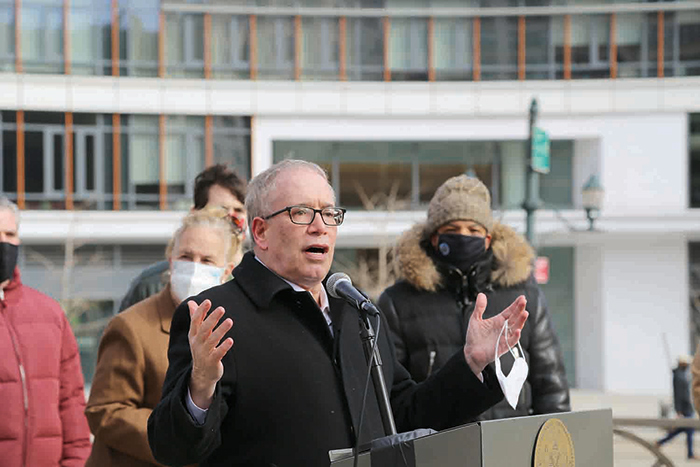Photo Courtesy of Comptroller Stringer’s Office
“This year’s budget can lay the foundation for our immediate and longer-term recovery—if we get it right,” Comptroller Stringer said.
By Forum Staff
City Comptroller Scott Stringer on Monday released an analysis of the City’s Fiscal Year 2022 Executive Budget and outlined the state of the City’s finances as COVID-19 vaccination rates continue to climb and a full reopening is underway. The new analysis of the Executive Budget spotlights the City’s planned spending of the federal COVID-related aid from President Biden’s American Rescue Plan Act. Comptroller Stringer called for the City to use the funds to enable a strong recovery and build a solid foundation for the future — notably ensuring a robust reopening of the economy and getting businesses and workers back, guaranteeing that the City’s financial condition is strong once stimulus funds are exhausted, and making the necessary investments needed to build the economy of the future.
The City’s Economic Outlook
- The U.S. economy is slowly recovering as a return to full employment has been lagging due to low wages, lack of childcare, supply bottlenecks, and a changing labor market.
- Despite positive momentum toward a full reopening — including a steady return of jobs, the return of 24/7 subway service and the scheduled reopening of Broadway —
the Comptroller’s analysis of the city’s economy reveals the extent of the remaining challenges, with unemployment rates stubbornly high particularly among New Yorkers of color, the number of SNAP and cash assistance recipients on the rise again, and small business revenue depressed.
FY 2022 Executive Budget
and April 2021 Financial Plan
- Thanks to the infusion of federal stimulus funds, the modified Executive Budget for FY 2021 is $100.7 billion dollars — $5.6 billion more than in January — and the Executive Budget for FY22 is $98.6 billion — up $6.2 billion dollars.
- Budget gaps of around $4 billion a year are projected to persist through FY 2025.
Federal Stimulus Aid
- The spending increases this year and over the remainder of the financial plan period are fueled by an additional $15.7 billion dollars in federal COVID-related aid in the budget.
- New York City stands to receive $5.9 billion in flexible funding from the American Rescue Plan Act stimulus aid, and nearly $7 billion for education from the ARPA and last December’s stimulus bill.
Responding to and Recovering
from the Pandemic
- Stringer’s analysis found that more than half of the federal stimulus funding will go to initiatives aimed at responding to the pandemic and reopening the economy.
- This funding includes investments in expanding disease control and lab capacity, reopening schools, vaccinations and immunization efforts, and testing and tracing.
- Other proposed initiatives include expanded rental assistance for the homeless or those at risk of homelessness; a citywide cleanup initiative; small business loans, grants, and other support; emergency food assistance and youth programs.
- The largest funding allocation — $3.6 billion — will go to DOE programs including academic recovery and student support services, special education services, and IT services.
- The budget does not provide details, however, on how a substantial portion of these funds would be used beyond very broad categories.
“This year’s budget can lay the foundation for our immediate and longer-term recovery—if we get it right,” Stringer said.

